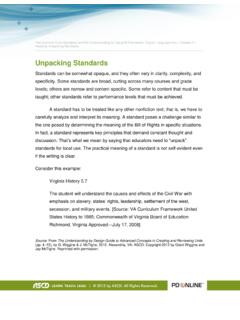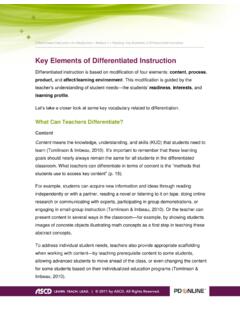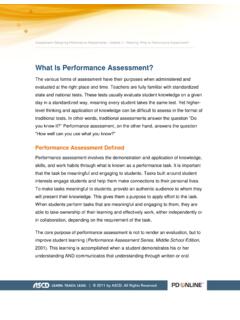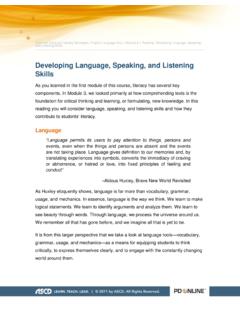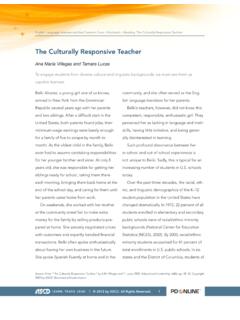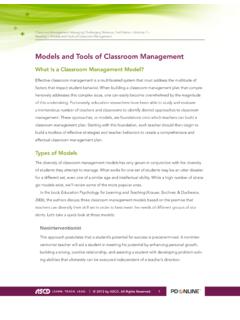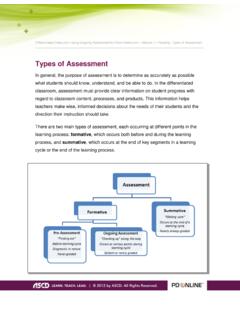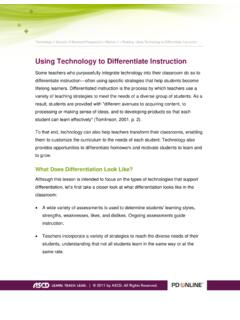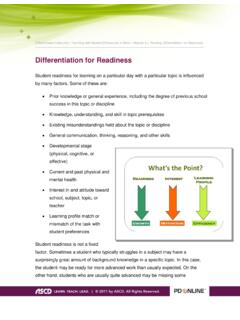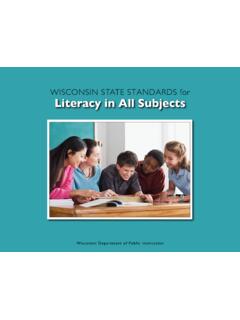Transcription of Using Formative Assessment to Help English Language ... - …
1 English Language Learners and the Common Core > Module 4 > Reading: Using Formative Assessment to help English Language Learners _____ Using Formative Assessment to help English Language Learners Maria Montalvo-Balbed With the implementation of the Common Core State Standards, Formative Assessment becomes an even more valuable tool for student success. With the slogan of higher, clearer, and fewer, the developers of the Common Core are hoping to better prepare students for college or career pursuits (CCSSO, 2010). Further, the end-of-year summative assessments being developed for Common Core standards contain performance tasks, so that our students must apply the content they learn beyond a simple recitation of facts. With the additional intellectual demands on students, it becomes vital that teachers provide feedback and check on student progress towards these standards, and that these Formative measures align with summative assessments. The importance of documenting and analyzing students daily Language experiences is not a new concept to teachers.
2 Even as new parents we are constantly evaluating our own children s Language output and comparing what they say and do with Language to the week before or the day before; we are continually aware of how much or how little they are learning once they start uttering words. And when I think of my own experience as a second Language learner, I am keenly aware of the changes in my Language development, and as such, those of my students. In my classroom, I use evidence of the students oral Language and written Language to provide documentation for the levels of students reading and listening skills. Through their speaking output and written work, I can determine whether they were able to comprehend the instructions, story, or task. That evidence tells me how well students were able to take ideas and put them into their own words after a listening activity or a reading experience. Meeting Higher Academic Demands When students are able to state a position or an opinion and provide evidence to back it up, I can better understand their comprehension levels.
3 And getting students to provide evidence for their opinions and arguments, along with engaging with more complex texts, are among key components of the new literacy shifts in the Common Core State Standards. So, if my students are unable to understand what they listen to, read, or discuss, then I need to take a step back and reassess my own teaching in light of the students level of Language development. Was the student able to successfully perform a classroom task because I made the activity meaningful and purposeful? Was the Language load English Language Learners and the Common Core > Module 4 > Reading: Using Formative Assessment to help English Language Learners bridged with scaffolding or was the success due to something else? Figuring out how to advance students learning both linguistically and academically is typically determined by my students performance on a task. This type of classroom activity is known as Formative Assessment . We really want [teachers] to think about Formative Assessment as being one of the key resources I don t mean item banks and small tests, but really to think about the instructional processes and practices and tools that give teachers instructionally relevant information during the act of instruction.
4 This is really at the heart of Formative Assessment , says Robert Linquanti, a researcher at the regional education agency West Ed who specializes in Assessment , evaluation, and accountability policies for English Language learners. Using Formative Assessment gives teachers a better understanding of their students Language and content understanding that is not provided by standardized summative assessments, which typically can t account for the Language proficiency level an English Language learner (ELL) has or the quality of his or her content instruction. For the Common Core math standards, which were designed for coherence within and across grades by focusing on key concepts, teachers can use Formative assessments as a way to check on students progress at key points along the way to ensure students build a solid conceptual foundation, procedural skills and fluency, and have the opportunities to apply that knowledge to solve problems in and even outside the math classroom.
5 What Formative Assessment Looks Like SEDL (formerly the Southwest Educational Development Laboratory) emphasizes that Formative Assessment is not a single event or measurement instrument but an ongoing, planned practice that lets teachers evaluate learning during instruction (2012). Formative Assessment also allows teachers to predict and make standardized judgments about student performance toward state and content standards, concludes SEDL s review of literature on the practice. In other words, the practice of Formative Assessment gives teachers a clearer picture of students learning progress. Formative Assessment can include the following elements (SEDL, 2012): Formative Assessment is a systematic, continuous process used throughout instruction: When you think of your own classroom, when does Formative Assessment take place during the lesson? In my own teaching, I know it takes place at all points of my lesson. For example, when I introduce a topic, I am very careful to front-load the Language and connect to students lived experiences within the subject to help bridge the connections they are to make with new words or new concepts.
6 I create scenarios that are brief and contextualized to help them get motivated to learn. I can gauge this by their behavior and brief responses to any given task. Sometimes this means that I cannot wait until the end of the class to do a ticket-out-the-door activity to assess the three types of sentences they English Language Learners and the Common Core > Module 4 > Reading: Using Formative Assessment to help English Language Learners learned during a lesson. Instead, I need to make sure that I know what I expect students to be able to do with regard to the learning goals and Language they use to express that day s learning. In that way, I can make adjustments during or after the lesson to help my students. Also, I use my observational or anecdotal notes on students progress and other ideas I may have to explain their rate of progress. This information helps me design instructional activities that are appropriate on a cultural and linguistic level for my students. Formative Assessment evaluates student learning as it happens: Once students have access to vocabulary, texts, and concepts through visuals, media, and interaction with the instructors and their peers, I assign them a task that will allow them to further their comprehension collaboratively with their peers.
7 I am very careful to differentiate the manner in which they will interact during the task so that I can determine whether they are being successful. This is the time for me to observe their interactions and the Language output, and this is also the time when I make small adjustments if a student or various students are not able to work on the task. Formative Assessment provides a feedback loop to adjust ongoing instruction and close the gaps in learning: It is important for me to demonstrate or model a process and use the Language I want the students to use in multiple modalities. When I provide feedback, I can help them see how the expectations were set and how far they have come in meeting those expectations. Sometimes I may need to do an extension activity because my student has far exceeded my instructional expectations. I need to think through these instructional pieces so that I can provide timely and relevant feedback. This practice ensures that the students feel hopeful that they are making progress but that they also understand they may need to revise or redo some work.
8 My students need to see that learning is an iterative process without feeling defeated. Formative Assessment actively involves both teacher and student: This means that my instruction includes my students. For example, I involve students in helping to develop a rubric by which they will assess their progress, based on the learning targets or goals for the day. My students help determine what will be acceptable work and what they will do to demonstrate they are learning. Formative Assessment also involves self- and peer Assessment : I need to teach my students how to self-assess and how to assess one another. We use our rubrics (developed together) to see how much progress has been accomplished and how to move forward. Students learn to see this as a way to make sure they are staying on task and helping each other take responsibility for their own learning. There are many tools that we can use to ensure that we are assessing our students Language development within a content area.
9 We must be sure we are not penalizing English Language Learners and the Common Core > Module 4 > Reading: Using Formative Assessment to help English Language Learners students by comparing their performance to anyone else in the class. I can set the expectations and be very clear about the goals and provide access to the content by making use of many different modalities and creating opportunities for the student to demonstrate conceptual understanding as well as Language development. Some of these tools can be checklists, anecdotal notes, rubrics, writing assignments, reading out loud, oral Language analysis, small quizzes, performance-based problems, or benchmarking. The important fact to remember is that research validates the use of Formative Assessment to improve learning for English Language learners (SEDL, 2012). Assessing Both Language Development and Academic Achievement In Using ongoing Assessment as a tool to make instructional decisions, Freeman, Ghiso, and Hamayan (2006) outlined some guiding principles to follow when considering the value of Assessment for English Language learners.
10 These authors believe that in the classroom, Assessment for learning rather than Assessment of learning should be the focus. In addition, they emphasize that teachers should focus on assessing Language development and academic achievement in English simultaneously. The continuous collection of Formative Assessment data should inform instruction by helping teachers make decisions about the what, the how, and the why behind their instruction. Using such data will allow teachers to determine students strengths and weaknesses in both content knowledge and Language development, making it easier to grade students separately in each area. As part of Formative Assessment practices, classroom teachers should consider Using the following strategies to gauge their students progress in both content and Language : Observations of student Language usage in speaking and writing Use of visuals to represent conceptual understanding Questioning: What types of questions do students ask about content and how they use Language ?
